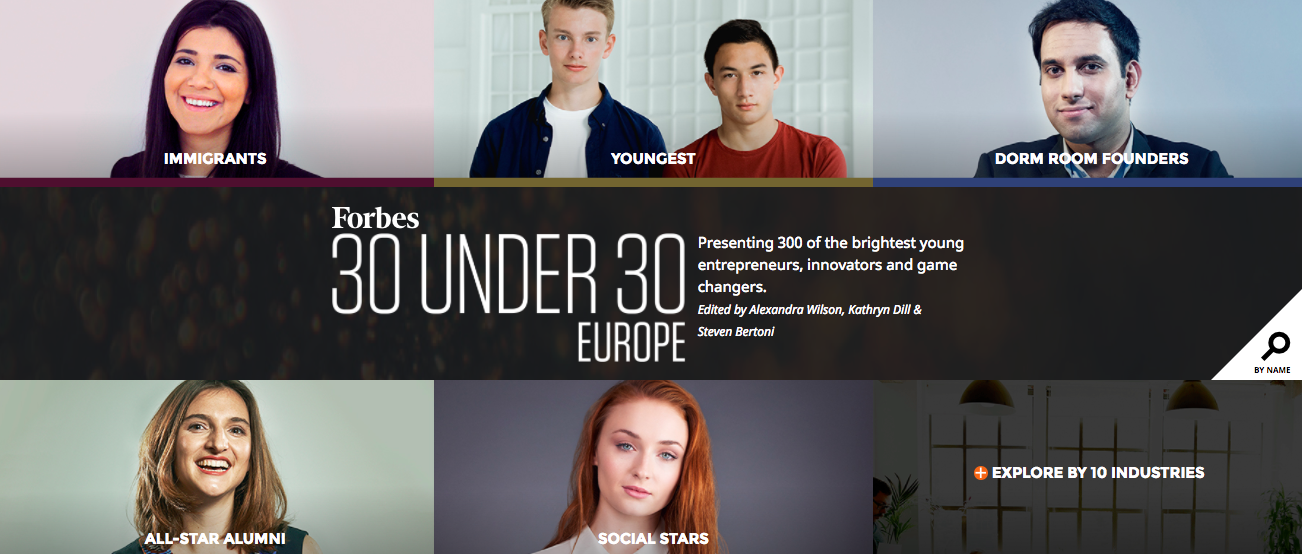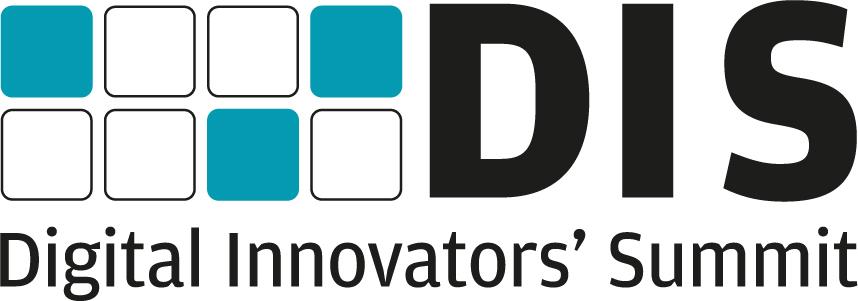Forbes’ revenue diversification into branded content and live events is big business
Forbes magazine recently announced its coveted 30 Under 30 list for Europe, naming business pioneers from a wide range of sectors including entertainment, finance, and technology. Celebrities like Rita Ora and Anthony Joshua are joined on the list by the likes of Mursal Hedayat, the 27 year old UK-based entrepreneur behind Chatterbox, an online language school that trains and employs refugees as teachers. And it’s not just the candidates that benefit from inclusion. Now in its seventh year, the 30 Under 30 list provides a successful flagship around which Forbes can build its progressive business brand and attract a new wave of emerging industry leaders.
With a diversifying portfolio and ambitions to ramp-up traditional editorial output alongside branded content and live events in 2018, the publication itself is clearly indicative of the capitalist spirit it represents. FIPP sat down with Mark Howard, chief revenue officer for Forbes Media and Charles Yardley, SVP and managing director of Forbes Europe, to find out where the media brand is placing its key focusses this year.
“The big thing that we’ve been working on at Forbes for the last several years is doing a good job of diversifying our revenues,” said Mark Howard. “Like most media companies, it wasn’t that long ago where we were heavily dependent on print. But in 2013, we actually saw our digital revenues catch up to and surpass print, and digital continues to grow beautifully really on three core pillars: the programmatic dollars are continuing to grow significantly, direct digital, which takes on mobile and video and all the other ways in which your relationship with the buyer and marketplace exists, and digital branded content is also a tremendous growth area for us.”
“So the digital piece of the pie still continues to grow very aggressively driven by those three pillars. We’ve also been very focussed though on expanding beyond that, including still through the magazine, which provides a very good revenue stream for us. Additionally, we have a custom research business called Forbes Insights that has been growing at a very aggressive clip the last couple of years as well as our live business. Things like the Under 30 Summit, and we’re going to be doing a European Summit in Amsterdam in September, we do a global summit in Tel Aviv in May, we do a US event in Boston in October, and an event over the summer in June or July in Asia. We are making our events a cornerstone of what we do and we’re working more and more with our partners to add that live touchpoint component to a lot of the bigger types of packages that we take to market, so it’s all been part of a bigger growth strategy.”
Charles Yardley expands on some of the specific projects that the publication will be bringing to market in 2018: “Mark refers to the success in revenue diversification and in this marketplace the two platforms that we are going to centre our efforts on to ensure that we grow this year will be the branded content side of the business, and our live events practice. In 2018 we’ll go from last year where we had our first inaugural CMO summit – we had about 85 marketeers from a plethora of different verticals and categories… panels, fireside chats, interesting dialogue with our 30 Under 30 list members, from a number of key clients and advertisers that we work with. That has now blown out to a full day summit that we’ll do this year. We’ll also be doing a CIO summit in May, building off the success of the CIO summits that we had in the US, and of course the ‘piece de resistance’ being the 30 Under 30 summit, bringing the largest global franchise that the business has to Europe for the first time, which is going to be in Amsterdam.”
Attending the 30 Under 30 event, which took place at London’s exclusive 100 Wardour Street venue last week, it is apparent that there is still an appetite amongst millennials for business success. With celebrities speaking with social entrepreneurs, finance professionals mingling with media owners, the Forbes community offers a wide-reaching content vertical that helps to connect, as well as simply inspire its audiences. This, too, is of benefit to the now century-old publication. As business changes alongside the world around it, uniting millennial audiences around shared social and entrepreneurial ideals offers a prime opportunity for Forbes to attract a new generation of readers.
“The 30 Under 30 franchise has been a real strong point for us over the last several years,” says Howard. “It launched in the States seven years ago, this is our third year in Europe, and we’re also in our third year in Asia, so we’ve been able to identify those individuals that are under the age of thirty who really do set out to change the world from a number of different categories. It ranges from social entrepreneurship, to investment and banking, technology, media, advertising.”
“So it really does cut across all different sectors and for us as a brand it’s been a great way to identify that the world of business has changed. A lot of younger folks these days have opportunities to use some of the tools of the modern day web era of big data, crowd funding, social networking, and are using it for good. They’re using it to start businesses, or transform businesses or disrupt industries with the purpose of doing social good or typically mission driven initiatives behind whatever it is that they’re doing. And for us to be the brand that’s bringing them all together has really been transformative, not only for us but also in helping to build the relationship with the next breed of business leaders.”

“Live events are playing a critical role in terms of our ability to really expand our relationships with a lot of our partners. You can only do so much through a media relationship, but when you have that opportunity to either add custom research or the live element where we can convene people around certain subject matters, topics, or interest areas and be able to aggregate those folks and put those brands in the room to have interesting conversations, it really does change the dynamics of our relationships with our partners. It becomes a much more complete way for us to think about what value we can add to them in terms of helping them solve their marketing challenges.”
And it’s not just diversified revenue streams that present an opportunity for growth in 2018. At a time when we see consolidation in the newsroom in other sectors of the industry, Forbes is actively looking to grow its editorial roster this year. Charles Yardley explains how a successful commercial strategy can feed back in to increased editorial momentum:
“This year we’re not just committing to the commercial side of the business by building out the live events practice, but we are actively going to be building out our editorial footprint. Not just through a bigger, wider network of contributors, but also taking on-board more Forbes staffers and building a bigger newsroom in Europe. I think to be fair we’ve been – from an editorial staff or a newsroom standpoint – fairly lighter on the ground than perhaps some of our competitors over the years. So now it feels like the right time, we’ve got the right momentum that we can build on that, and build a more substantial footprint throughout the continent.”
Howard explains that diversifying into new content and new revenue streams, does not necessarily need to mean cannibalising the main product.
“It does take on all different types of form and factors,” says Howard. “Of course social has conditioned you to think that’s what right for LinkedIn is different to what’s right for Instagram. It’s different from our own website from a mobile web experience. So we are thinking about content holistically and it comes through a lot of different expressions these days. We’ve got editors and a newsroom of producers and other folks who support that idea that to tell a good story, you need to not only have the story itself but also understand the way it needs to be disseminated across every possible touchpoint, that makes sense. Not every social platform is appropriate for every story, not every story necessarily needs to be broken up into digestible pieces.”
“We find that quite a bit of our content is still being consumed on our mobile website. People find it through all different kinds of different ways, organic search, social, referrals from other places, and in those instances we’re able to still deliver a very good experience for those people. We focus a lot on ‘How do you deliver everything fast?’ It doesn’t matter what the environment is, but especially in a mobile environment people want their content and they want it to be delivered as fast as possible. We’re constantly working on that concept, and the different form factors that it takes on, that is really more about the story itself and the points you are trying to deliver.”

Finally, we asked Howard and Yardley about the changing nature of the business world itself. With digital and more recently social technology having completely revolutionised not only the traditional media industry, but business across every single sector, does the emerging generation of entrepreneurs still carry with them the same attitudes towards business that earlier entrepreneurs did.
“Yes, absolutely, and I think you see that just by looking at the list members and the businesses that they’re involved in and attached to,” said Yardley. “I suppose probably the single biggest change-maker in the last fifteen or twenty years is probably the mobile phone. It’s played such a big part in allowing these individuals to suddenly scale and grow their businesses very, very quickly. That’s coupled with the fact that, I think there’s an interesting statistic that Randall Lane our editor gave refers to in that more people now apply to be on the Forbes 30 Under 30 list than do to go to Harvard… so maybe now more and more people are interested in going straight to work and being more entrepreneurial than perhaps going down a sort of academia route.”
Mark Howard says: “The Forbes brand has always stood for championing entrepreneurial capitalism and what’s amazing is in our 101st year right now that concept of entrepreneurial capitalism rings true from a global business perspective. People feel like they do have the opportunity should they want to branch out and take a swing at something that they can, and that there’s lower barriers to entry due to technology than ever before, greater access to capital than ever before, greater access to information. So that empowerment is something that we want to continue to not only champion, but inspire. And we believe that we’re the brand that people turn to look for that type of inspiration. That’s whether they’re ready to do that themselves and pursue that editorial path or want to just bring that mind-set to whatever job they have – that’s really what we stand for, and what people look to us for.”
*Join FIPP and colleagues from around the world at the 11th FIPP and VDZ Digital Innovators’ Summit taking place on 19-20 March in Berlin, Germany, where we will talk about developments around paid content, ecommerce, advertising and more. Discounted Early Bird rates are about to end, so visit innovators-summit.com today to learn more and to sign up before the Early Bird offer ends.
 |
More like this
How Hearst UK is developing ‘Events-as-a-Service’
Four industry experts share insights on innovating live events
How Recode thinks about their events
100 years of Forbes… and the future to come
Events: Think differently, says Cannes Lions director
Forbes launches Bankable, a career, money and balance initiative









